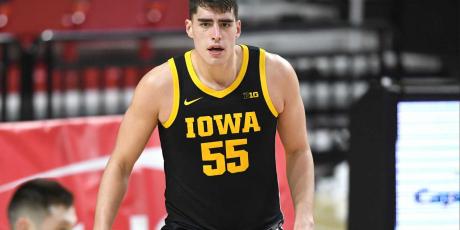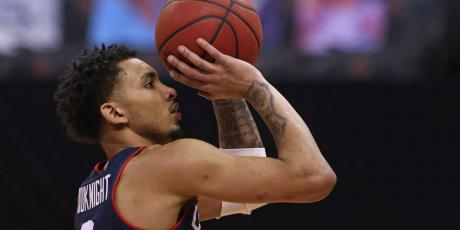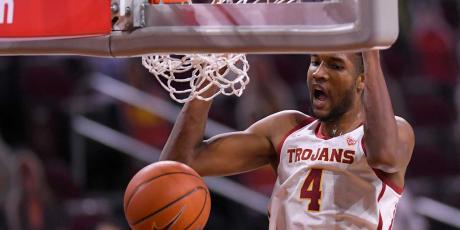March Madness Bracket Strategy Part 1

March Madness is back! After a COVID-19-fueled hiatus in 2020, the tournament is set to begin on March 18th with the “first four” play-in games. Between brackets, betting, and non-stop action for the next few weeks, this is arguably one of the best times of the year. The primary goal of this article is to help people make smarter decisions when filling out their brackets and win their pools! Read Part 2 of this article. Plus, Matt Gajewski has highlighted his top Cinderella Teams and Bracket Busters.
Basic Strategy
Pick All the 1-Seeds Over 16-Seeds
No. 1 seeds are 139-1 in the first round of the NCAA tournament—Virginia was the only loss as a No. 1 seed (2018 against UMBC). Ignore that outlier and pick all the No. 1 seeds to win their first game.
Pick at Least One 12-Seed to Beat a 5-Seed
No. 12 seeds are 50-90 (35.71%) against No. 5 seeds since 1985. At least one No. 12 seed has beaten a No. 5 seed in 30 of the past 35 years.
Use Betting Spreads to Make Picks & Choose “Upsets”
Plain and simple, the betting market is much more efficient than bracket seeding. For example, in 2019, Wisconsin (5) vs. Oregon (12) was a No. 5 seed vs. a No. 12 matchup, but Wisconsin was only a one-point favorite. If we compare this to another No. 5 seed vs. No. 12 seed matchup between Auburn and New Mexico State, Auburn was a 7.5-point favorite. If you want to pick a No. 12 seed to win, you are much better off taking Oregon than New Mexico State. A normal person filling out a bracket sees two No. 12 vs. No. 5 matchups. Looking at the spread tells a different story, though, as Wisconsin and Oregon are essentially 50/50 to win. Oregon won by nearly 20 points while Auburn escaped with a narrow victory, but the point remains true. The same thought process should be applied to every game you pick, especially between No. 8 vs. No. 9, No. 7 vs. No. 10, and No. 6 vs. No. 11 seeded matchups where most bracket entries will likely choose randomly. Early betting lines are out now. Make sure to also read what three Cinderella teams Matt Gajewski believes can make a long postseason run.
Utilize Win-Probability Models
Okay, so maybe this one isn't so basic, but it's worth your time if you want to win your pool. Beyond leveraging spreads from sportsbooks, I also use TeamRankings' win probabilities. They help you decide which team is the better choice for each round. For me, it is just another piece of the puzzle that has led to success over the years. I'll also be writing a companion piece to this article that will exclusively focus on which teams are the best value based on how frequently people are picking them to win compared to TeamRankings' win probability. Stay tuned.
Editor's Note: Click here for an exclusive TeamRankings discount to gain the ultimate edge in your March Madness bracket.
Choosing a Winner
Even if you pick nearly everything right in the first few rounds you will still likely need to pick the winner in order to take home the money in your pool. Leveraging historical data from KenPom.com to analyze past winners can help guide us in what to look for. This isn’t an end all be all but can help us identify what to look for when choosing a potential winner.
Before we dive in, below are the key metrics to understand:
- Adjusted Efficiency Margin: How efficient a team is on offense and defense, adjusted for how good their opponents were.
- Adjusted Offensive Efficiency: How efficient a team is on offense, adjusted for how good their opponents were.
- Adjusted Defensive Efficiency: How efficient a team is on defense, adjusted for how good their opponents were.
This key provides a more in-depth explanation.
Balance is Key
Fifteen of the past 18 winners ranked in the top six in adjusted efficiency margin heading into the tournament.
For the notoriety of upsets and “madness,” in the tournament, winners are almost always good, well-balanced teams.
This year the top-six teams in adjusted efficiency margin are:
- Gonzaga
- Michigan
- Illinois
- Baylor
- Iowa
- Houston
Offense Wins Championships
Seventeen of the past 18 winners have ranked inside the top 25 in adjusted offensive efficiency.
All of the teams from the previous list rank in the top 25 in offensive efficiency, so there are no worries there. Some of the other consensus top-25 teams overall fail in this test, though:
- Alabama’s offense is just 34th, largely because of injuries that spurred sluggish offensive performances. I’m okay with ignoring this as they averaged nearly 80 points this season and are electric when fully healthy.
- Loyola Chicago’s offense is 49th in adjusted offensive efficiency. Part of the reason they are so low is that the “adjustment” for strength of schedule brings them from 26th in raw offensive efficiency down to 48th. That might be a bit of an overreaction.
- Wisconsin (32nd in AdjO), USC (30th in AdjO) and Arkansas (35th in AdjO) are the only teams I would actually be worried about not having enough offensive firepower to sustain a deep run.
Getting Defensive
The winner with the worst adjusted defensive efficiency was Duke in 2015 (57th, overall), while the average winner’s defense ranked 16th and the median is 11th. This is where I believe things get scary this year with a few of the more highly-regarded teams.
Iowa’s defense is ranked 50th in adjusted defensive efficiency. This technically fits our parameters but pushes the limits. The bigger issue is that all Big 10 teams' metrics are adjusted heavily because they mostly play other Big 10 teams. If you don’t take into account the opponent adjustment, Iowa’s raw defensive efficiency is 158th—the worst defensive team to win in KenPom’s database ranked 72nd in raw defense.
Ohio State’s defense is ranked 79th in adjusted defense and 244th in raw defense. While they are certainly talented enough to beat almost anyone, their defensive woes leave them ripe for an upset.
Baylor hasn’t looked the same post-COVID and will be rolling into the tournament with the 44th-ranked adjusted defense. Among all the winners since 2002, only Duke’s 57th-ranked defense was worse. Every other team had a defense that ranked 37th-or-better in adjusted defensive efficiency.
Potential Winners
Based on all the factors above and each team’s draw, these are my favorite teams to make a deep run and potentially win the tournament. I’ll be releasing another article later this week finalizing my favorite picks as public pick percentage comes out. That will allow us to gain leverage on the field—another very important aspect of winning your bracket.
Gonzaga (No. 1 Seed, West)
The Zags have the best adjusted efficiency margin in KenPom history entering the tournament. That’s right, better than any historic Kentucky, Duke or Kansas team. It’s seemingly unimaginable for Gonzaga to be better than those goliaths of years past but they are truly the whole package. They rank No. 1 in adjusted and raw offensive efficiency, scoring 1.2 points per possession, according to TeamRankings. Gonzaga ranks 10th in adjusted defense and 12th in raw defense. They also led the nation in 2-point field goal percentage made at 63.9%. One of the biggest knocks on Gonzaga’s previous teams entering the tournament was that they didn’t play anyone good and their gaudy win rate was fraudulent.
This year’s team doesn’t fit that billing. They have beaten Kansas (22nd in adjusted efficiency margin), West Virginia (27th), Iowa (5th), Virginia (11th) and BYU (24th) three times. They fit all the criteria of the research listed above and have a future lottery pick in guard Jalen Suggs. Not to mention their draw in the bracket wasn’t relatively difficult. A team of this caliber rebranded as blue bloods like Kentucky or Duke would certainly be picked in 50% or more of brackets to win, but I think there’s a chance Gonzaga comes in well under that.
Illinois (No. 1 Seed, Midwest)
Illinois is another team that fits all the criteria and is now fully healthy heading into the tournament. They rank seventh In adjusted offense, fifth in adjusted defense, third in adjusted efficiency margin, and have more big wins under their belts than almost any other team in the country. They have a dominant center in Kofi Cockburn and a future NBA player in Ayo Dosunm—two elite players at their respective positions. They probably have the toughest second-round draw in the tournament among No. 1 seeds, facing either Loyola Chicago or a surging Georgia Tech team fresh off an ACC championship.
Michigan (No. 1 Seed, East)
Michigan’s season-long metrics are spectacular, ranking sixth in adjusted offense, seventh in adjusted defense and second in adjusted efficiency margin. Despite the strong statistical outlook, you should proceed with caution when picking Michigan. Senior forward Isaiah Livers is out indefinitely with a stress injury. He has a 21.4% shot rate, meaning that when he was playing he was taking a good chunk of the team’s shots. They are also in a bit of a slump with three of their four total losses this season all coming in their past five games. They also have a potential tough second-round draw against either LSU or St. Bonaventure.
Houston (No. 2 Seed, Midwest)
Houston could be a great pick for those in bigger bracket pools. They are from a mid-major conference (American) and surely won’t garner the ownership of other big programs. Houston ranks sixth in adjusted efficiency margin, eighth in adjusted offense and 16th in adjusted defense. They are the second-best team in the country in offensive rebounding rate, and well-rounded in almost every other metric. All three of their losses this season came on the road and they have notable wins against Memphis (38th in adjusted efficiency margin) as well as Texas Tech (23rd). With an over-seeded West Virginia as the No. 3 seed in their side of the bracket, Houston has a great chance of squaring off against Illinois in the Elite 8.
Thanks for reading and stay tuned for part two of my bracket strategy series that will leverage TeamRankings' data and analysis to help us find "value" picks for different-sized bracket pools. We'll also have betting content throughout the rest of the tournament. Our official betting subscription will be available in the coming days with exclusive articles and a Discord chat where Matt Gajewski and myself will post our daily college basketball bets throughout the tournament.












